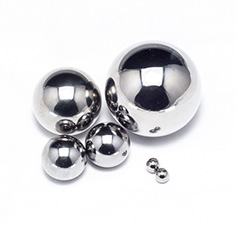
 Home > News
Home > News
In the field of medical equipment manufacturing, steel balls are critical components that directly impact the safety, stability, and durability of devices. As a specialized B2B supplier integrating both trade and production, we understand the importance of selecting the right stainless steel material. This article focuses on two widely used stainless steel grades—304 and 316—and highlights their differences in medical applications to help you make informed purchasing decisions.
304 stainless steel is one of the most commonly used austenitic stainless steels. It offers good corrosion resistance and mechanical strength, making it suitable for environments with moderate exposure to moisture and chemicals.
Key characteristics:
Composed of 18% chromium and 8% nickel, with no molybdenum;
Good oxidation and rust resistance;
High strength and excellent machinability;
More cost-effective than 316.
Common applications:
Outer components of medical devices;
IV and fluid transfer systems;
Disposable or non-critical moving parts in medical tools.
316 stainless steel contains 2–3% molybdenum, which significantly enhances its resistance to corrosion, particularly in chloride-rich environments such as saline and disinfectant exposure.
Key advantages:
Superior resistance to chlorides and chemical corrosion;
Ideal for high-moisture, high-corrosion medical settings;
Better biocompatibility, suitable for higher medical standards;
Slightly better heat resistance than 304.
Typical applications:
Core components in devices like pacemakers, infusion pumps;
Implantable medical devices (subject to certifications);
High-end medical valves, sealing systems, and bearing balls.
Your choice depends on the environment and performance requirements:
| Condition/Requirement | Recommended Grade |
|---|---|
| Budget-sensitive projects | 304 Stainless Steel |
| Exposure to saline or disinfectants | 316 Stainless Steel |
| High corrosion resistance needed | 316 Stainless Steel |
| General IV or injection equipment | 304 Stainless Steel |
| Precision parts in high-end devices | 316 Stainless Steel |
As a one-stop supplier with deep expertise in steel ball manufacturing and trading, we offer:
Traceable 304 & 316 stainless steel balls
Precision up to ±0.001mm
Compliance with ISO, ASTM, DIN, and other global standards
Flexible batch customization and fast delivery
In the medical field, precision and reliability matter. A small steel ball plays a big role in ensuring device performance and patient safety. While 304 and 316 may seem similar, choosing the right one can make a significant difference. For consultation, technical support, or custom orders, feel free to contact our team—we’re ready to deliver tailored solutions that meet your exact needs.
View More(Total0)Comment Lists